Blasting is a type of metal surface treatment in which an abrasive material is struck onto the product to apply the treatment.
However, what is blast processing used for in the first place?
In this article, we will discuss the characteristics and common problems of blast processing.
What is blasting process?
Blasting is often heard of in requests for metal surface finishing or metal treatment. The word “blast” is written in English as “blast,” which means “to blow or blow out.
In other words, it is a processing method of “spraying something. Please see the picture below (a capture of our company introduced on TV).

Do you see it?
You can see something white spewing out from the nozzle tip.
In this case, it is being sprayed onto the stainless steel plate.
The surface is then roughened, patterned, shimmering, or pear-shaped.
This is the blasting process.
There are a lot of ways to call the blasting process, why?
There are several variations within the blasting process.
So, it is often described as shot blasting or air blasting.
This is due to the difference in the way they are blasted.
The major categories are
Air blasting (blasting with dry air)
Wet blasting (blasting using water power)
Wet blasting (using water power) Shot blasting (using an impeller mechanism to hit the projectile)
Shot blasting (beating the projectile with an impeller mechanism)
What’s the difference between each method of blasting?
Air blasting is usually used for rust removal, decoration, and paint pretreatment.
Wet blasting is used for cleaning and blasting oiled mechanical parts, and wet blasting is ideal for blasting metals that are prone to explosion.
Shot blasting is used for shot peening of mechanical parts and wear-resistant parts, as well as for peeling off the black skin of castings, as it uses a powerful impeller to knock down heavy projectiles.
Incidentally, air blasting is commonly used to apply design decoration to stainless steel, titanium, and aluminum.
What do you spray with blasting?
There are several types of blasting that can be done.
There are several types of blasting, which are roughly divided into different applications.
■For decoration
Glass beads
Zirconia beads
■Rust removal, paint pretreatment, paint removal
Alumina blasting (commonly known as sand blasting)
Cut wire for iron and stainless steel
■Shower plates in vacuum equipment, etc.
Powder blasting
■Vacuum equipment anti-adhesion plates
Silicon carbide and alumina
We use different materials for different purposes.
Does the appearance change when what is blasted changes?
How does the appearance change when what is sprayed changes?
Take a look at the pictures below.
This was all done by air blasting, with different projectiles.
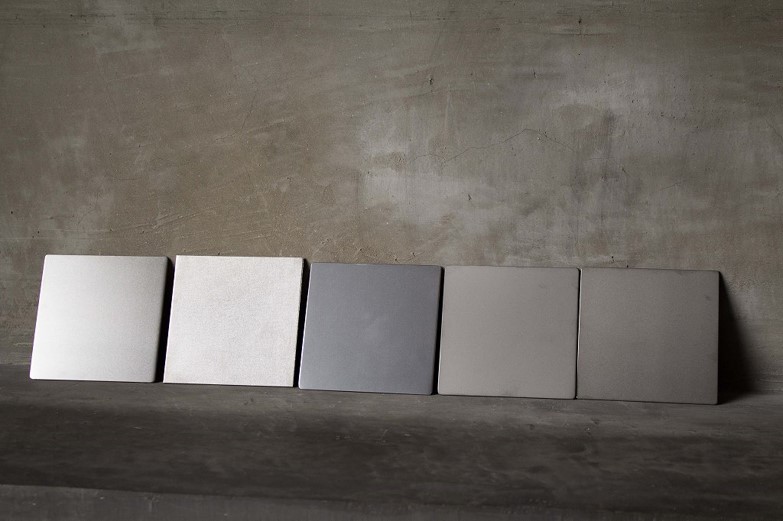
The density of the material to be blasted, the density of the blasting material (jet volume), the projection distance (distance between the outlet and the material), and the pressure of the air can make a big difference.
What do you think? The good thing about blasting is that it can be adjusted to suit the image and the application.
Incidentally, blasting parts that are fed into the heart of semiconductor and LCD manufacturing equipment requires precise control. It requires very detailed manufacturing capabilities, including particle size control and post-application roughness control. Furthermore, in the case of aluminum parts, cooperation with plating manufacturers is essential because of the compatibility with anodizing.
What are some of the common problems with blasting?
Let me explain some of the most common problems.
First of all, it is necessary to control the projectiles (spraying materials and equipment) for each material to be treated.
For example, let’s say you blast stainless steel using the same blast projectiles and equipment that were used to remove the black skin from steel and to pre-treat the paint. If this is done, fine iron powder will adhere to the surface of the stainless steel, and [rust] will occur. The result is a brownish bump that makes you sad, even though you were expecting a beautiful design. This point is very important.
Next is warping, deformation, and distortion.
If the proper procedures and equipment are not followed, the struck material will warp, bend, deform, and distort. This is especially true for plates, which can be bent and cannot be recovered. This too, must be done with great care.
Then there is the residue.
Blasting is a spraying process. Therefore, when the blasted material hits the surface, it breaks up and leaves a fine, microscopic residue on the surface.
In the case of parts such as electronics equipment, the residue becomes dust and has a negative impact. This is something to be very careful about. In the case of shower plates, the holes are clogged. In the case of shower plates, the holes are clogged and no gas is released.
Difference between bead blasting and sand blasting
Bead blasting, sand blasting, and blasting are often described in a mixed manner. Sandblasting” is often used for decorative purposes, while “beadblasting” is used for paint removal.
To explain the difference in simple terms
Bead blasting involves hitting a round sphere.
Sandblasting involves hitting a spiky ceramic object.
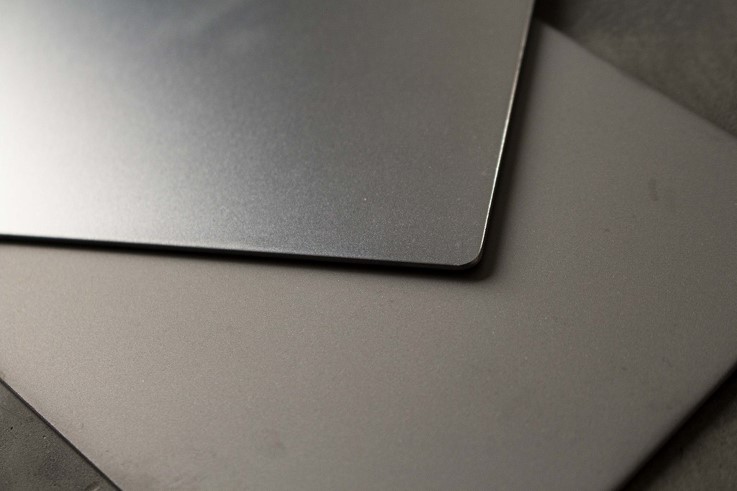
The top photo shows bead blasting, and the bottom photo shows sand blasting.
The colors are completely different, and each has its own characteristics.
Characteristics of bead blasting and sand blasting
This section explains the characteristics of general bead blasting and sand blasting.
■Bead blasting
Bead blasting is a decorative finish with a beautiful shimmer and cloudy surface, like the matte finish of precious metals.
■Sandblasting
The surface is rough and does not reflect light such as glitter. Paints and adhesives bite firmly with an anchoring effect.
Sandblasting is more susceptible to hand stains and dirt.
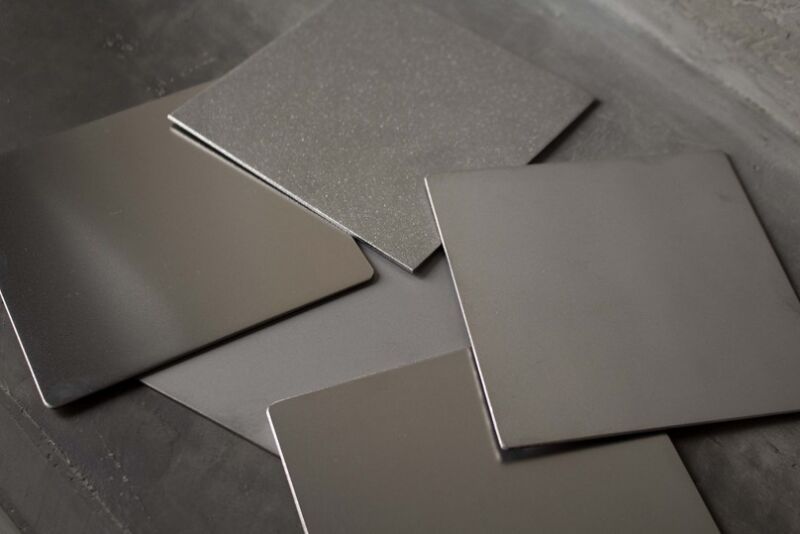
In the case of stainless steel, bead blasting is recommended if you are concerned about getting rust outdoors. If you still want a matte finish, use titanium as the base material. If you still want a matte finish, use titanium as the base material. It will not rust. In fact, titanium tiles are alumina blasted (sand blasted).
How to decorate stainless steel by bead blasting?
Bead blasting on stainless steel is often combined with mirror finishing. The result is a beautiful contrast and a gorgeous finish.
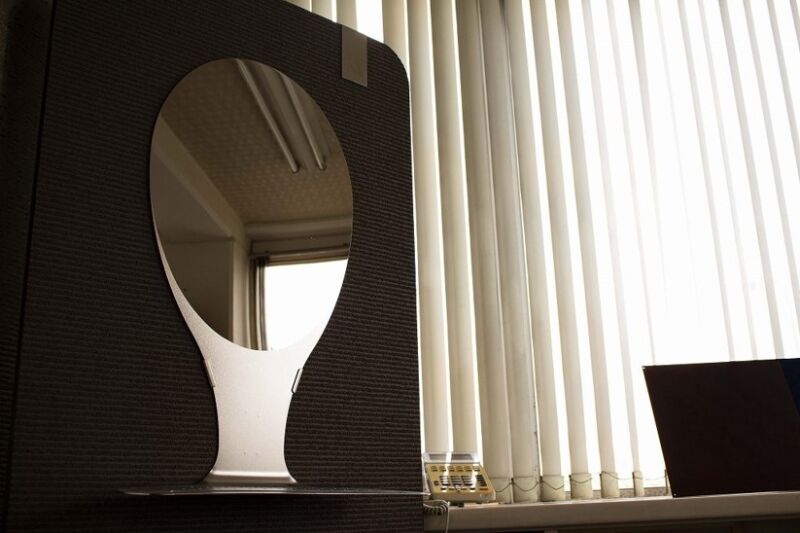
In this way, it can be combined with a stainless steel mirror surface.
(This is a product called “Drop,” an unbreakable mirror, which is no longer manufactured, but when it was manufactured in the past, it won a prize at the Fukuoka Design Awards.
Finally
I have explained about the blasting process which is used in many industries and applications. The blasting process varies depending on the application and purpose.
Also, if you are not careful with the process, problems can often occur.
When you make a request, please tell us in detail about the purpose and conditions, and we will respond with the most suitable processing method.
For example, if you want to make a stainless steel fixture that is matte and sparkles! Please do not buy materials that have been blasted.
#If you want to make a stainless steel fixture with a matte finish, please do not buy blasted materials. 700 polished materials are used for processing, welding and finishing, and the last step is blasting.
If you don’t do this, you will end up with a beautiful fixture that is disappointing because of the residual unevenness that develops in the welded and fabricated areas that do not match the color. We can process whole kitchens, whole flush doors, and whole store fixtures. Please feel free to contact us.
Finally, for those who say, “But the hand stains are ・・・・
Please apply 【Macoat_GC】 after the final blasting.
It will protect the surface well. Please consider it as well.
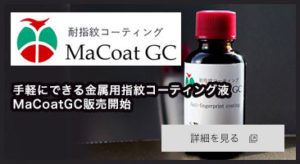
【Keep beautiful designs forever】
We are selling a coating solution that anyone can use easily and simply to prevent fingerprints. The “MaCoatGC” is a fingerprint resistant coating liquid that can be applied to metal only by applying the liquid. The coated metal is almost invisible to the eye. Since the liquid coating can be applied easily to any shape or location of metal, it is being used in a variety of applications such as three-sided frames of elevators, interior partitions, and artwork. Please contact us directly for purchasing information.
